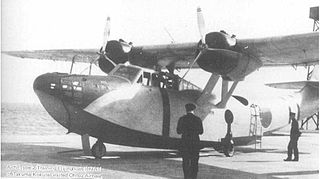
The Kawanishi H8K is a flying boat used by the Imperial Japanese Navy Air Service during World War II for maritime patrol duties. The Allied reporting name for the type was "Emily".

The Aichi H9A was an Imperial Japanese Navy Air Service flying boat used during the first years of World War II for crew training. An uncommon type, it was not encountered by Allied forces until spring 1945, and was never assigned an Allied reporting name.

The Beriev MBR-2 was a Soviet multi-purpose flying boat which entered service with the Soviet Navy in 1935. Out of 1,365 built, 9 were used by foreign countries including Finland and North Korea. In Soviet Union it sometimes carried the nickname of "Kорова" (cow) and "Амбар" (barn).

The Supermarine Southampton was a 1920s British flying boat, one of the most successful flying boats of the interwar period. It was a development of the Supermarine Swan, which was used for a ten-passenger service between England and France.

The Aichi E16A Zuiun was a two-seat reconnaissance seaplane operated by the Imperial Japanese Navy during World War II.

The Blackburn R.B.2 Sydney was a long-range maritime patrol flying boat developed for the Royal Air Force in 1930, in response to Air Ministry Specification R.5/27. It was a parasol-winged braced monoplane of typical flying boat arrangement with triple tailfins and its three engines arranged on the wing's leading edge. After evaluation, it was not ordered into production and no further examples were built.
The Kawanishi H3K, also known as Navy Type 90-2 Flying Boat (九〇式二号飛行艇), was a Japanese biplane military flying boat from the interwar period. The H3K was a development of the Short S.8/8 Rangoon. The first of the H3Ks was built by Short Brothers and the remaining four by Kawanishi in Japan.

The CAMS 37 was a flying boat built in France in the mid-1920s that was originally designed for military reconnaissance, but which found use in a wide variety of roles in a large number of versions. It was the first design for Chantiers Aéro-Maritimes de la Seine (CAMS) by the company's new head designer, Maurice Hurel. The prototype was displayed at the 1926 Salon de l'Aéronautique in Paris. The prototype first flew in 1926, and after testing was ordered into service before the end of the year. It was a conventional biplane flying boat very similar to previous CAMS designs, being driven by a pusher propeller whose engine was mounted on struts in the interplane gap. The first production version was the amphibious CAMS 37A that was bought by the French Navy, the Portuguese Navy and the aeroclub of Martinique.

The CAMS 55 was a reconnaissance flying boat built in France in the late 1920s which equipped the French Navy throughout the 1930s.
The Latécoère 611 was a French four-engined maritime reconnaissance flying boat of the Second World War. Although only a single prototype was completed, this served throughout the war, being used by both the Vichy French and Free French navies.

The Potez-CAMS 141 was a French long range reconnaissance flying boat of the late 1930s. Intended to equip the French Navy, only a single prototype was completed before the German invasion of France stopped production. That prototype did, however serve operationally from bases in French North Africa until scrapped in 1943.

The Potez 540 was a French multi-role aircraft of the 1930s. Designed and built by Potez, it served with the French Air Force as a reconnaissance bomber, also serving with the Spanish Republican Air Force during the Spanish Civil War. Although obsolete as a bomber, it remained in service in support roles and in France's overseas colonies at the start of World War II.

The Potez 452 was a French flying boat designed and built by Potez in response to a French Navy specification for a shipboard reconnaissance machine for use on its battleships and cruisers.

The Supermarine Nanok was a British three-engined biplane flying boat built by Supermarine. Built to meet a Royal Danish Navy requirement, the single prototype was rebuilt as a private air yacht and renamed the Supermarine Solent.

The Lohner L was a reconnaissance flying boat produced in Austria-Hungary during World War I. It was a two-bay biplane of typical configuration for the flying boats of the day, with its pusher engine mounted on struts in the interplane gap. The pilot and observer sat side by side in an open cockpit, and both the upper and lower sets of wings featured sweepback.
The Ikarus IO was a biplane flying boat produced in Yugoslavia in the late 1920s. It was a conventional flying boat design for its day, featuring a large single-bay wing cellule, the staggered wings of slightly uneven span braced with N-struts. The pilot and observer sat side by side in an open cockpit, and a gunner sat in an open position ahead of them, in the bow. The pusher engine and frontal radiator were carried on struts in the inter-plane gap.
The Aichi AB-4 was a Japanese flying boat of the 1930s. A single engined biplane, the AB-4 was intended to carry out night reconnaissance for the Imperial Japanese Navy. Six were built and accepted into service as the Experimental 6-Shi Night Reconnaissance Flying boat, three of which were converted to civil transports.

The Short N.3 Cromarty was a prototype British twin-engined biplane flying boat, designed towards the end of the First World War. Only a single example was built, which first flew in 1921 and was wrecked in 1922.
The Bréguet 790 Nautilus was a prototype French three-seat coastal patrol flying-boat designed and built by Bréguet Aviation to meet a requirement from the French navy.
The SNCASE SE-400 was a prototype French twin-engined coastal patrol floatplane of the Second World War. A single example was flown, but development was abandoned in May 1940 owing to the German invasion of France.














